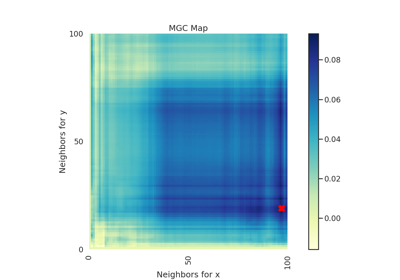CCA¶
-
class
hyppo.independence.CCA¶ Cannonical Correlation Analysis (CCA) test statistic and p-value.
This test can be thought of inferring information from cross-covariance matrices [1]. It has been thought that virtually all parametric tests of significance can be treated as a special case of CCA [2]. The method was first introduced by Harold Hotelling in 1936 [3].
The statistic can be derived as follows [4]:
Let \(x\) and \(y\) be \((n, p)\) samples of random variables \(X\) and \(Y\). We can center \(x\) and \(y\) and then calculate the sample covariance matrix \(\hat{\Sigma}_{xy} = x^T y\) and the variance matrices for \(x\) and \(y\) are defined similarly. Then, the CCA test statistic is found by calculating vectors \(a \in \mathbb{R}^p\) and \(b \in \mathbb{R}^q\) that maximize
\[\mathrm{CCA}_n (x, y) = \max_{a \in \mathbb{R}^p, b \in \mathbb{R}^q} \frac{a^T \hat{\Sigma}_{xy} b} {\sqrt{a^T \hat{\Sigma}_{xx} a} \sqrt{b^T \hat{\Sigma}_{yy} b}}\]The p-value returned is calculated using a permutation test using
hyppo.tools.perm_test.
Methods Summary
|
Helper function that calculates the CCA test statistic. |
|
Calculates the CCA test statistic and p-value. |
-
CCA.statistic(x, y)¶ Helper function that calculates the CCA test statistic.
-
CCA.test(x, y, reps=1000, workers=1)¶ Calculates the CCA test statistic and p-value.
- Parameters
x,y (
ndarray) -- Input data matrices.xandymust have the same number of samples and dimensions. That is, the shapes must be(n, p)where n is the number of samples and p is the number of dimensions.reps (
int, default:1000) -- The number of replications used to estimate the null distribution when using the permutation test used to calculate the p-value.workers (
int, default:1) -- The number of cores to parallelize the p-value computation over. Supply-1to use all cores available to the Process.
- Returns
Examples
>>> import numpy as np >>> from hyppo.independence import CCA >>> x = np.arange(7) >>> y = x >>> stat, pvalue = CCA().test(x, y) >>> '%.1f, %.2f' % (stat, pvalue) '1.0, 0.00'
